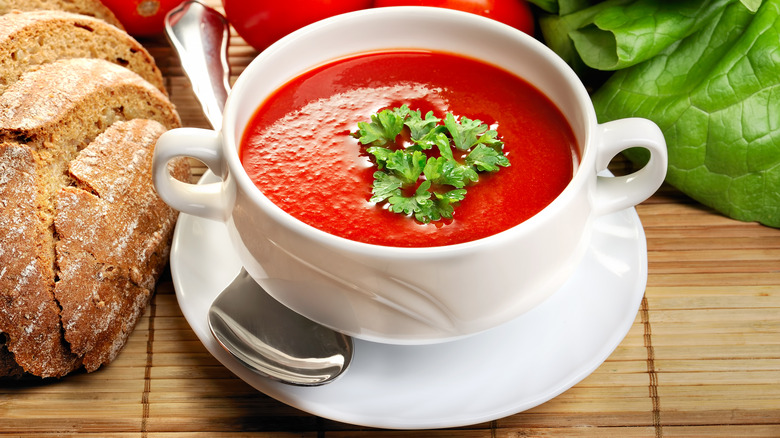The Classic Campbell's Soup You Need To Leave In The Past (And Out Of Your Shopping Cart)
There's no denying that Campbell's soups are revered classics. Although the soups have graced American homes since the 1890s, the company's history dates back to 1869. Back then, it was known as Anderson & Campbell firm, and in 1876, it became known as Joseph Campbell Preserve Company. It was in 1895 that the company launched its very first can of tomato soup and set the stage to become known for iconic soups. Its debut canned soup was a classic beefsteak tomato that was met with great demand once it hit the market.
Two years later, the company introduced condensed soups. This revolutionary idea reduced its soup cans from 30 ounces to an economical 10 ¾ ounces by eliminating water, saving the company canning material and its consumers money. Despite such noteworthy achievements, we ranked Campbell's condensed tomato bisque last in our taste test for 14 store-bought tomato soups, and our reasons may surprise you.
It is unclear when Campbell's condensed tomato bisque entered the market, but its ingredient list is similar to that of its regular condensed tomato soup. The base ingredients include tomato puree, water, and sugar. However, the biggest difference is that the bisque includes cream and diced tomatoes in tomato juice. Naturally, it delivers a richer soup with a chunky texture as opposed to the smoothness of Campbell's regular condensed soup, though being richer and chunkier doesn't make it better.
Why we ranked Campbell's Tomato Bisque Soup last
Reflecting on the best tomato soups, you think rich, red, and redolent. Put that against an overly fruity, chemical-tasting can of Campbell's condensed tomato bisque, and you'll regret parting with your hard-earned coins. According to our Tasting Table taste testers, the flavor was miscalculated. Plus, it lacked the robust tomato essence that makes tomato bisque iconic.
What's more, the texture of Campbell's condensed tomato bisque becomes too runny once you add water to it as instructed. We've talked previously about the main differences between soup and bisque, stressing the latter's creamy texture, yet you might mistake this bisque for the former if you slurped it with your eyes closed. The bisque was too thin and underwhelming in texture, and its slightly off-red color gave it an unnatural appearance that triggered doubts about its taste, which were, sadly, confirmed.
We also ranked Campbell's regular condensed tomato soup near the bottom at number 12 out of 14 as it fell short of its acquired reputation. With the precedent set by the bisque, it didn't do much to redeem itself and followed a similar fashion of donning a poor color and weak flavor. The soup had a dull red color, tasted cheap, and was void of the vibrant tomato taste we love in tomato soups. But, it was the overly runny texture after adding the recommended can of water that put the final nail in the coffin for Campbell's tomato soup.
The hallmarks of a great can of tomato soup
The best canned tomato soups harbor a ketchup-intense flavor watered down by a savory broth, so they're slightly sweet yet tangy. The color can range from deep orange to deep red. Most importantly, there's no aftertaste — the aromas of canned tomato soup should start and finish strong with no metallic flavor to put a dent in your enjoyment.
Texture-wise, look for bisque that's velvety with a creamy mouthfeel and maybe even chunky bits of tomato for a fun texture. If you've already picked up a brand that is too thin, we have an article showing you how to turn canned tomato soup into an exquisite bisque. The method is so simple and efficient that you might end up stocking up on bisque-to-be canned soups.
Then, there's sodium. Although the recommended daily allowance is less than 2300 milligrams per day, you don't want to fulfill it all in one meal! Soups generally contain between 500 and 1800 milligrams per cup on average. With Campbell's tomato bisque at 1740 milligrams per cup (870 milligrams per serving), it lands above our other reviewed soups, such as Pacific Foods' organic garden tomato oat milk soup (410 milligrams per cup/serving) and the same brand's tomato bisque (590 milligrams per cup/serving). Much like these, your healthiest soup options will limit the sodium to an amount on the lower end of the recommended daily allowance spectrum, so anything with approximately 360 to 600 milligrams per serving is ideal.


